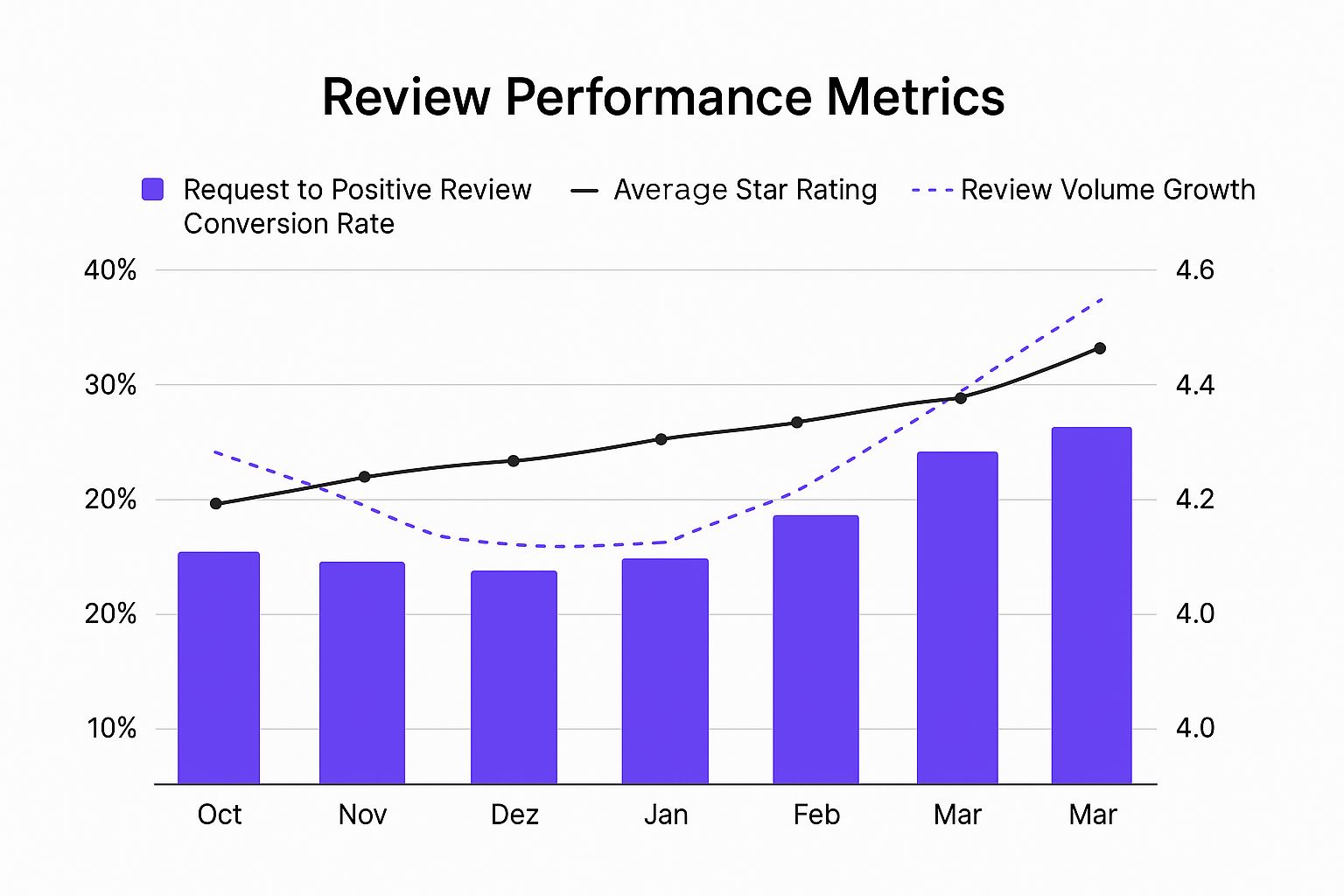Mastering How to Manage Online Reviews
Learn how to manage online reviews with proven strategies. Turn feedback into brand trust and growth, and discover how to get more positive reviews.
Posted by
Think of online reviews less as a report card and more as your secret weapon for growth. It’s not about just getting five-star ratings; it's about building a system where every single piece of customer feedback—good, bad, or indifferent—becomes a direct line to making your business better and winning over new customers.
Why Managing Reviews Is Your Biggest Growth Lever

Let's be real. Reviews are the new word-of-mouth, and they have a direct say in your bottom line. When people are swimming in options, what do they look for? Social proof. They want to see what real people, just like them, have to say about you.
A smart review strategy is what separates the businesses that are killing it from those that are just getting by. This isn't about scrambling to hide a one-star review. It's about creating a loop where customer voices actively build your brand's authority and make you more visible.
The Straight Line Between Trust and Sales
The link between reviews and what people buy is rock-solid. A staggering 95% of consumers read online reviews before they even think about making a purchase. This makes your reviews a critical checkpoint in their buying journey.
It's simple: great reviews can send your sales through the roof. Bad ones? They can turn potential customers away in a heartbeat.
The numbers don't lie. Research shows that just a one-star bump in your average rating can increase revenue by 5-9%. This isn't a vanity metric. It’s a real, tangible driver of your financial health.
Sitting back and hoping for the best just doesn't cut it anymore. Every single review is a chance to either solidify a great impression or to show everyone watching how much you care by fixing a problem.
The data paints a clear picture of why this matters so much. Here’s a quick look at the core numbers that drive the importance of review management.
Key Statistics on Consumer Trust and Online Reviews
| Statistic | Percentage of Consumers | Business Implication |
|---|---|---|
| Reading Reviews Before Purchase | 95% | Your reviews are a mandatory stop for nearly every potential customer. Neglecting them means ignoring your audience. |
| Trust in Online Reviews | 79% | The vast majority of consumers trust online reviews as much as personal recommendations from friends or family. |
| Positive Reviews Influence Purchase | 94% | A strong collection of positive reviews makes consumers significantly more likely to use a business. |
| Negative Reviews Deter Customers | 92% | Just a few negative reviews can be enough to convince potential customers to look elsewhere. |
| Need for Recent Reviews | 73% | Consumers believe that reviews older than three months are no longer relevant, requiring a steady stream of new feedback. |
These statistics aren't just interesting facts; they represent the modern consumer's mindset. Your online reputation is actively being shaped by them every single day, whether you're participating or not.
A Powerful Edge Over the Competition
In a packed marketplace, your online reputation is what makes you stand out. When someone searches for a local service or a new product, what they see in your reviews could be the final nudge that gets them to choose you over someone else.
A healthy mix of recent, positive reviews sends a powerful signal to both customers and search engines like Google. It tells them you’re trustworthy, relevant, and delivering a great experience. This doesn't just sway buying decisions; it gives your local SEO a serious boost, helping you climb the rankings and pull in more organic traffic.
For any company trying to build a brand that lasts, a smart strategy for reputation management for small business is non-negotiable.
Ultimately, when you treat review management as a growth lever, it becomes part of how you do business—woven into your marketing, customer service, and even product development. It’s also a cornerstone of effective customer retention strategies, because it proves you’re listening to the customers you already have, making them want to stick around.
You can't manage what you don't see.
Trying to handle online reviews without a solid monitoring system is like trying to catch rain in a thimble—you’ll get a little bit, but you'll miss the flood of feedback that actually matters. A bulletproof monitoring system ensures no customer voice, good or bad, ever slips through the cracks.
It all starts with figuring out which platforms actually matter for your business. Don't just default to the big names; you need to go where your specific customers are talking.
Where Are Your Customers Leaving Reviews?
For a local coffee shop, the world probably revolves around its Google Business Profile, Yelp, and maybe a few local food blogs. But for a national e-commerce brand selling niche hobby gear? They need to cast a much wider net, keeping an eye on major product review sites, social media chatter, and even industry-specific forums.
The review landscape is huge and always shifting. As of early 2025, Google is still the undisputed heavyweight—a whopping 83% of US consumers use it to vet local businesses. But other players have serious clout. Yelp users churned out 21 million reviews in 2025 alone, and 40% of Americans peek at a company's Facebook page for feedback. You can dig into more of these online review trends at Backlinko.
A great way to get started is to simply list out every possible place a customer might talk about you:
- The Big Three: Google, Yelp, and Facebook are non-negotiable for most.
- Industry-Specific Sites: Think Trustpilot for SaaS, Zocdoc for doctors, or Angi for home services. Where does your industry live online?
- Social Media: This isn't just about direct @mentions. You need to be aware of Instagram comments, X (formerly Twitter) threads, and even conversations happening in relevant Reddit communities.
- E-commerce Marketplaces: If you sell on Amazon, Etsy, or any other third-party site, those product reviews are gold.
Once you have this list, you can figure out the right tools for the job.
Choosing Your Monitoring Tools
If you’re a small shop with just a couple of key platforms to watch, you might be able to get by with native alerts. Google and Yelp will happily email you when a new review pops up.
But let's be real—as soon as your business grows or your online footprint expands, that manual approach falls apart. Fast.
Investing in a dedicated review management tool isn't a luxury; it's a necessity for any business serious about its reputation. These platforms pull all your reviews into a single dashboard, saving you from the daily grind of checking ten different sites and preventing a bad review from festering unnoticed.
Take a platform like Trustpilot, for example. It's a major hub for online service and e-commerce reviews.
For any business in the digital space, sites like this are a primary source of customer feedback. A proper monitoring tool doesn't make you log into Trustpilot, then Google, then Facebook. It pulls everything from these sites directly into one unified workflow.
This is how you build a process that can scale. Instead of your team logging into a dozen different websites each day, they log into one system. It creates consistency, slashes response times, and gives you a true pulse on customer sentiment everywhere, without all the chaos.
Crafting Responses That Build Brand Loyalty

Responding to online reviews is where the rubber meets the road for your brand's personality. Every single reply is a public conversation, a chance to show customers you're actually listening. This is how you turn simple feedback into die-hard loyalty.
Think about it: trust in online reviews is at an all-time high. A recent study found that 54% of consumers now trust online reviews more than recommendations from family or influencers. And with 68% of people forming an opinion after reading just one to six reviews, your replies carry some serious weight. It’s no surprise that 86% of people will actively steer clear of a business with bad reviews, a point driven home in this deep dive on review statistics.
A Framework for Handling Negative Reviews
Getting a negative review feels like a punch to the gut. We've all been there. But your response can completely flip the script. The trick is to act fast, lead with empathy, and know when to move the conversation out of the public eye.
Whatever you do, don't get defensive. Instead, lean on a simple framework:
- Acknowledge and Apologize: Kick things off by thanking them for the feedback. Then, offer a genuine apology for their bad experience. A simple, "We're so sorry to hear your visit didn't meet your expectations," goes a long way.
- Show You're Listening: Reference a specific detail from their review. This proves you’ve actually read their comment and aren't just pasting a canned response. Something like, "We understand how frustrating it is when an order is delayed," shows you get it.
- Take It Offline: Give them a direct line—an email or a phone number—to resolve the issue privately. This demonstrates you're serious about fixing things while also protecting their privacy.
- Stay Professional: Remember, your reply is for every potential customer who will read it, not just the unhappy one. Keep your tone calm, helpful, and professional.
Your goal isn't to win an argument online. It's to show everyone watching that you care and take full responsibility. A well-handled negative review is often more powerful than a dozen positive ones.
Making the Most of Positive Reviews
Just dropping a "Thanks!" on a glowing review is a huge missed opportunity. This is your chance to double down on what makes your brand great and build a real connection with your biggest fans.
A great response to positive feedback should be more strategic:
- Get Personal: Use their name. Mention something specific from their review that they loved.
- Reinforce Your Strengths: If they praised your speedy shipping, you could say, "Our warehouse team will be thrilled to hear that!"
- Give Them a Reason to Return: Invite them back to try a new product or mention an upcoming promotion. It keeps the relationship going.
So, instead of a boring "Thanks for the review," try something like: "Hi Sarah, we're so thrilled you loved the lavender latte! Our baristas work hard to perfect that recipe. We hope you'll come back soon to try our new seasonal pastry!" For more powerful ways to engage with praise, mastering Google review reply tactics is a fantastic resource for building that loyalty.
Don't Ignore the Neutral Reviews
Those three-star reviews? They're a goldmine of constructive criticism. These customers didn't hate their experience, but something held it back from being amazing. Honestly, this is often where you'll find the most actionable feedback.
Treat these reviews with the same care you give the negative ones. Thank them for their honest take, acknowledge their specific points (both the good and the bad), and let them know you’re using their comments to get better. This balanced approach proves you’re not just coasting—you’re always pushing for excellence.
Learning how to capture these detailed experiences can transform your marketing from good to great. If you want to turn happy customers into your most powerful advocates, check out our guide on how to write a testimonial that truly connects with people.
How to Ethically Generate More Positive Reviews
Let’s be honest: just waiting around for good reviews to show up isn't a growth strategy. It's a game of chance. If you really want to build a strong online reputation, you have to be proactive. That means encouraging your happiest customers to share their experiences and create a steady stream of social proof that does the selling for you.
The trick is to make it completely effortless for them. Think about their journey with your business. When are they most excited? That’s your golden moment. It might be right after they hit "buy," after a fantastic chat with your support team, or when your product finally solves that nagging problem they had.
Timing Your Review Request Perfectly
Asking for a review is all about timing. Ask too soon, and they haven't had a chance to appreciate what you offer. Ask too late, and that initial buzz has faded. It's a delicate balance.
Based on my experience, here are a few high-impact moments to send that request:
- Right after an e-commerce purchase confirmation. Their excitement is at its peak.
- After you've successfully resolved a customer support ticket. They feel heard and appreciated.
- A few days after the product arrives. This gives them just enough time to actually use it.
- At checkout in a physical store. A simple QR code on a receipt or a small sign works wonders.
And please, no generic email blasts. A little personalization goes a long way. A simple SMS or email saying, "Hi [Customer Name], we hope you're loving your new [Product Name]! Would you mind sharing your experience?" feels human and respectful, not like a marketing robot.
Make the Process Effortless
The more hoops a customer has to jump through, the less likely they are to leave a review. Every single click you add to the process kills your conversion rate. Seriously.
Your goal should be to get the customer from the request to the review form in a single click. Pre-fill any information you can and link them directly to the "leave a review" page on Google, Yelp, or wherever you need it most. Don't make them go hunting for it.
For a deeper dive into making this process seamless, our guide on how to get customers to leave reviews is packed with more actionable tips.
Different methods for asking for reviews come with their own pros and cons. I've seen businesses have massive success with SMS, while others swear by in-person QR codes. It really depends on your customers and your business model.
Review Solicitation Method Comparison
| Method | Effectiveness | Implementation Effort | Best For |
|---|---|---|---|
| Email Request | Moderate | Low | E-commerce, B2B, service businesses with strong email lists. |
| SMS/Text Message | High | Low-to-Moderate | Businesses with a younger demographic or where mobile interaction is common. |
| QR Code (In-Person) | Moderate-to-High | Low | Restaurants, retail stores, local service providers with physical locations. |
| Phone Call | High | High | High-value B2B clients or services where a personal relationship is key. |
Choosing the right mix of these methods is what separates a trickle of reviews from a steady flow. Test what works for your audience and double down on it.
This infographic really drives home how a proactive strategy impacts the numbers that matter, like conversion rates and your overall star rating.

As you can see, a systematic approach doesn't just get you more reviews—it improves the quality and sentiment, which is a powerful signal to potential customers.
Staying Compliant and Ethical
This is a big one: you have to play by the rules. Major platforms like Google and Yelp have zero tolerance for incentivizing reviews with cash, discounts, or freebies. They also frown on "review gating," which is when you screen customers and only ask the happy ones for a review. Getting caught can get your entire listing penalized or removed.
Your strategy should always be about encouraging all customers to share their honest feedback. Authenticity is what builds trust in the long run. To get this right, learn how to request a testimonial the proper way. When you stick to ethical practices, you build an authentic online reputation that actually drives real, sustainable growth.
Turning Review Data Into Actionable Insights

The real gold in your reviews isn't just the star rating; it's the raw, unfiltered feedback buried in the comments. Responding to reviews is non-negotiable, but analyzing that feedback is what separates the pros from the amateurs. This is where you shift from simply reacting to proactively making your entire business better.
Think about it. If you keep getting five-star reviews that rave about your "lightning-fast shipping," you've just found a core strength to shout about in your marketing. On the flip side, if three different three-star reviews mention a "confusing checkout process," you’ve just been handed your next big website project on a silver platter.
You’re turning customer chatter into a strategic roadmap.
Uncovering the Real Trends in Customer Feedback
The first step is to start looking for patterns. Don’t just get lost reading reviews one by one. You need to zoom out and group them into themes. This is often called sentiment analysis, but you don't need fancy software to start—just a keen eye for what people are really talking about.
A good starting point is to create categories that actually matter to your business.
For a restaurant, this might look something like:
- Food Quality: What are people saying about the taste, the presentation, or the menu itself?
- Customer Service: Is the staff friendly? Attentive? Fast?
- Ambiance: Comments on the decor, the noise level, or how clean the place is.
- Price & Value: Do customers feel they got their money's worth?
Categorizing your feedback like this immediately pulls you out of the weeds. You’re no longer guessing what to fix or what to promote; you're using direct customer intelligence to guide your every move. A simple spreadsheet can get you started, or you can use a review management tool to automate a lot of the heavy lifting.
The goal here is to create a feedback loop where customer insights directly fuel your business strategy. When you approach online reviews this way, you’re not just managing your reputation—you’re building a blueprint for constant improvement, designed by the very people you’re trying to serve.
Putting Those Insights Into Practice
Once you've spotted these trends, it's time to actually do something about them. Insights are completely useless if they just sit in a spreadsheet.
Let's say multiple reviews for your new software mention a "clunky user interface." That's not just a complaint to smooth over with a polite reply. It's a critical piece of intel for your product development team. Your job is to package that feedback, share it with the right people, and brainstorm real solutions.
And don't forget to close the loop. Let your customers know you're working on it. This proactive approach does so much more than just fix problems. It screams to your customers that you’re listening and that their opinions truly matter.
That's how you build fierce loyalty. It's how you transform the simple task of collecting reviews into a powerful engine for real, meaningful growth.
The Tricky Questions: Your Review Management FAQ
Let's be honest, navigating the world of online reviews can feel like walking through a minefield. Business owners I talk to are always running into the same tricky situations and asking the same nagging questions. Getting these answers right is what gives you the confidence to protect your brand’s reputation without losing your mind.
So, let's clear up some of the most common challenges you're going to face.
How Should I Handle a Fake Review?
First thing's first: don't panic. A fake or malicious review is incredibly frustrating, I get it. But reacting emotionally online is a losing game—it just makes things worse. The best approach is a calm, procedural one.
Every major platform like Google and Yelp has a process for flagging reviews that violate their policies. This should always be your first move. Report the review for what it is: spam, a conflict of interest, or completely off-topic.
While you wait for the platform to do its thing, you can (and should) post a brief, professional public response.
Here's a good template: "We take all feedback seriously, but we have no record of this customer or transaction in our system. We have reported this review to the platform for investigation as it appears to violate their content policies."
This simple reply shows other readers you're on top of the situation without dragging you into a messy public argument. Stick to the facts and keep emotion out of it.
Should I Ever Delete a Negative Review?
The short answer is a hard no. For one, on most platforms, you can't delete reviews yourself anyway. But even if you had a magic button to make them disappear, it's a terrible idea.
Think about it. A page full of nothing but glowing five-star reviews looks suspicious to savvy consumers. It feels fake.
A few negative reviews, when you handle them well, actually build credibility. They prove you're a real business that, like any other, sometimes makes mistakes. More importantly, they show you’re committed to fixing them. The only time you should ever pursue removal is when a review is clearly fake, abusive, or breaks the platform's rules.
How Fast Do I Need to Respond?
Speed matters. A lot. You should aim to respond to every single review—both positive and negative—within 24 to 48 hours.
It’s not just a gut feeling; the data backs it up. A 2024 study from Birdeye highlighted that businesses boosted their response rate by 10% from the previous year. The trend is clear: faster engagement is becoming the standard.
A prompt reply to a negative review can de-escalate a tense situation and show the customer you genuinely care. For positive reviews, a quick "thank you" keeps the goodwill flowing. Using a review management tool to get instant notifications is a game-changer here, ensuring nothing slips through the cracks.
Ready to stop guessing and start growing? EndorseFlow pulls all your reviews into one place, automates your requests, and gives you the tools to turn customer feedback into your most powerful marketing asset. Start your free 14-day trial today.